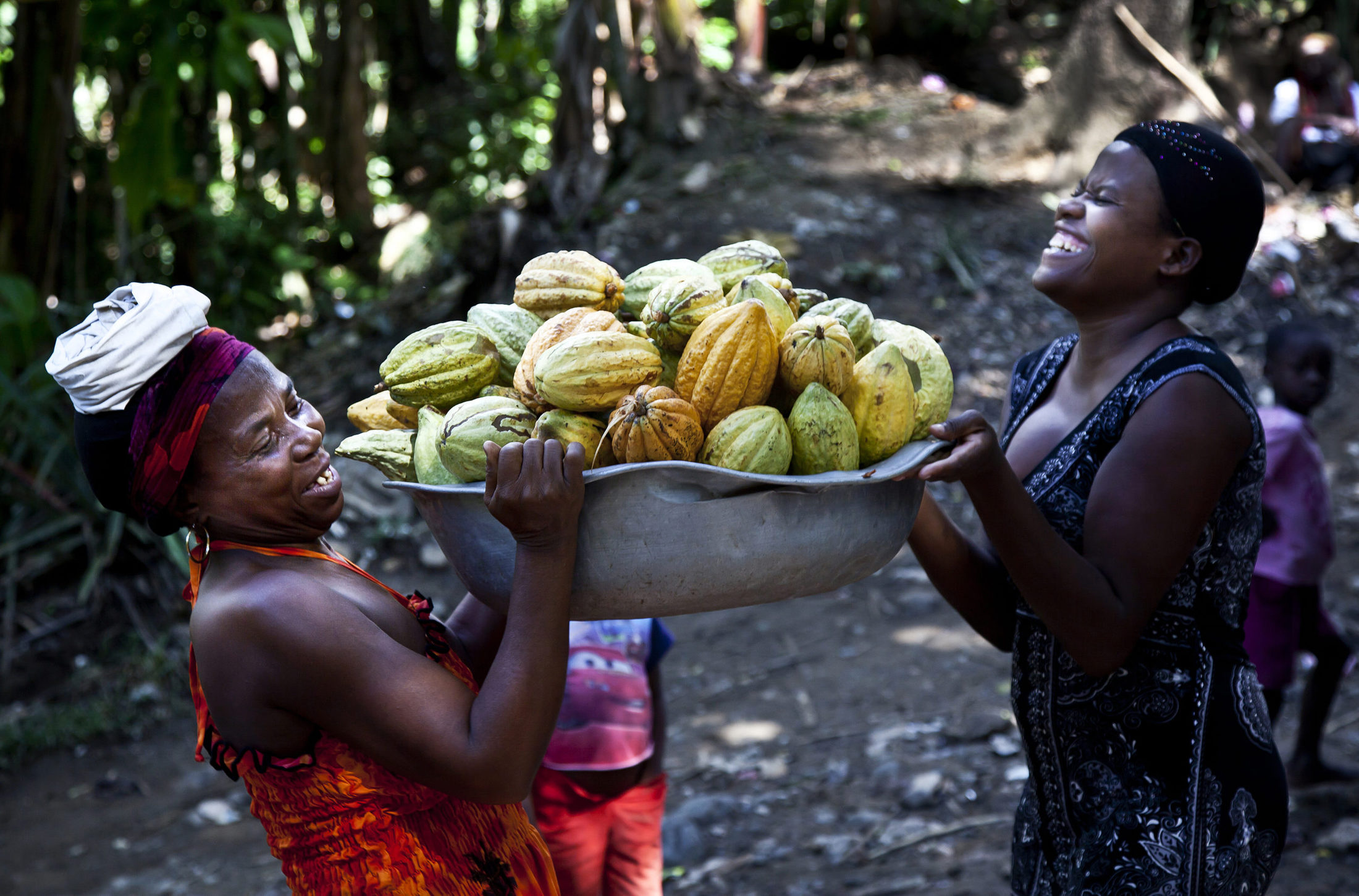
Building a Stronger Haiti with Chocolate
Meet the Michigan Engineer who walked away from a six-figure career to help farmers and create jobs, building Haiti’s first bean-to-bar chocolate operation in her hometown.

Meet the Michigan Engineer who walked away from a six-figure career to help farmers and create jobs, building Haiti’s first bean-to-bar chocolate operation in her hometown.
“OK, adventure!” The weary crew looks up as Corinne Joachim Sanon announces herself, her face emerging from the rainy night. Squeezed into the bed of a covered pickup, her crew has spent all day harvesting cacao in an isolated Haitian farming village. Sanon budgeted three hours for the 70-mile trip back to town. That was seven hours ago.
At 11 p.m., they’re stranded at a gas station near the city of Cap Haitien. Torrential rain has turned the road ahead into a river. To make matters worse, the driver of one of the two hired pickup trucks has given up and turned back. The 10-member crew is now shoehorned into a single vehicle along with 14 buckets of raw cacao beans. The cacao is snugly sealed against the rain blowing in. The crew, not so much. Soaked to the skin, they sit on benches, buckets and each other.
To stay fresh, the beans need to get to the fermentation and drying center near the town of Ouanaminthe within 24 hours of harvest – that’s 8 a.m. It’s not going to be easy.
Outside, the gas station’s lights lend a glow to pounding raindrops. The station is closed but they’ve left the lights on for security, drawing a swarm of stranded buses and motorcycles. The heavy air smells of charcoal smoke and sodden travelers. Creole rap music plays from a radio.
In many places, a night like this would qualify as a catastrophe. In Haiti, it’s a hurdle – discouraging but not entirely unexpected. There’s nothing to do but handle it. And, dressed in a pink tank top, khakis and cornrows that point to a bun, that’s precisely what Sanon is doing.
The 32-year-old Michigan Engineering and Wharton School grad, industrial engineer and Haitian entrepreneur has found dinner for the crew. She passes out a stack of Styrofoam containers filled with fried chicken and cold spaghetti. She also brings news: the flood is worse than it looks. They may be stuck here until morning. She grins wryly behind her red-framed glasses. “We promised you adventure,” she says, and produces a stack of paper napkins, unaccountably dry.
For Sanon, the flood is just another variable in a decision tree that has been ticking through her mind since she founded Les Chocolateries Askanya two years ago. She left a six-figure consulting job in New York to be here, returning to her native Haiti to start the country’s first bean-to-bar chocolate operation. Located in Ouanaminthe, a border city in northeastern Haiti, Askanya harvests raw cacao beans and turns them into finished, wrapped bars.
Bean-to-bar had been done in a few other developing countries, like Grenada and Ecuador. But not in Haiti. Haiti has few good roads, little electricity and a government that’s often in flux. Nothing is easy when tomorrow could bring anything from a stolen wallet to a flood or a coup, and running a factory is a particularly tall order.
But Sanon has designed Askanya to do more than make chocolate. At its core, it’s a machine that churns out better futures for Haitians. Having grown up in Haiti, Sanon knew the hurdles to running a business here. Being an engineer, she knew she could overcome them.
“I was one of the lucky ones, far luckier than the majority of Haitians,” she said. “I went to a good school and a great university and have a great life. But I didn’t want to wake up at 60 having never tried to do anything for Haiti.”
So, Sanon divides her time between Askanya’s distribution center in Brooklyn and its factory in Ouanaminthe. She makes a fraction of her old salary, heading an operation that runs on hired pickups, hard labor and endless patience. It isn’t glamorous or high-tech, especially on nights like this.
“Most of the time, my family thinks I’m crazy,” she says. “They’d rather see me in a safer, more traditional career path. But they understand that this is what I choose, and they’ve grown more proud and supportive as they’ve seen the business growing.”
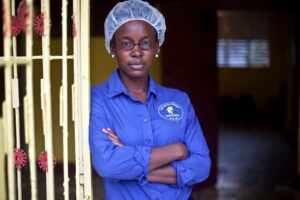
Askanya coaxes 6,000 artfully wrapped, organic, single-origin chocolate bars each month from one of the most unforgiving places on Earth, selling them to Haitian hotels, online buyers and high-end chocolate retailers. It employs dozens of workers and buys cacao from thousands of small farmers.
After a huddle with her team, Sanon decides to give up on reaching Ouanaminthe tonight. If the road clears, they’ll spend the night in Cap Haitien, a few miles away. They’ll need a safe place to stay. And they’ll need to get their cacao to the fermentation facility near Ouanaminthe by 8:00 a.m., a few hours from now. She pulls out her cell phone and starts making calls.
The start of the day couldn’t have been more different. Sun streamed through the leaves of banana trees overhead as the pickup crawled into the jungle on a cratered dirt path. Harvest trips like these happen two or three times each week during the two cacao seasons, from March through May and September through November. They start with the farmers nearest to Askanya and travel further out as the season progresses, journeying to the isolated villages where small farmers grow cacao. Usually, they work with about 50 farmers, turning 5,000 cacao pods into 1,600 pounds of raw beans.
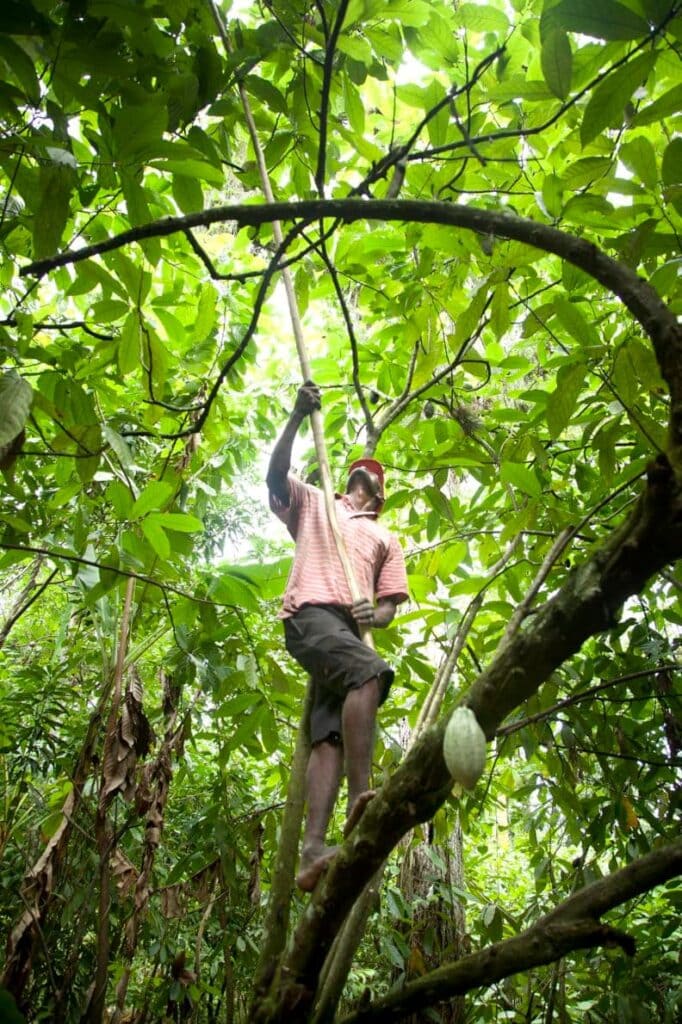
Small farmers have been walking these dirt roads for centuries. They make up 60 percent of Haiti’s population and an even larger part of its identity. After independence, they were allowed access only to the sloping land near the base of Haiti’s foothills – above its flat plains, but below the lucrative coffee-growing zones in the mountains. They’ve been growing crops like plantain, breadfruit, cacao and mango ever since, enough to eat and a little to sell.
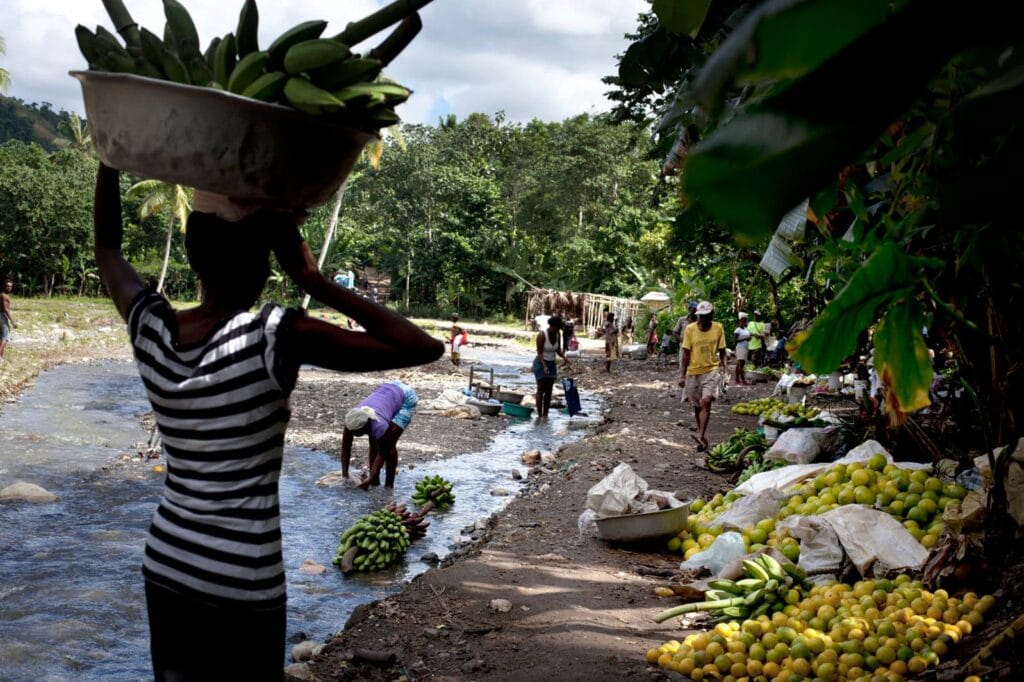
University of Guelph PhD candidate Jenn Vansteenkiste has been working with Haitian farmers for years. She says Haiti’s government has long ignored small rural villages, leaving a deteriorating infrastructure that makes it difficult for farmers to earn a living.
“The state has always been very extractive of the peasantry,” she said. “There are few schools, few health services, roads are poor. There needs to be investment, and that hasn’t happened.”
As a result, Haiti’s agriculture sector, which easily fed the country as recently as the 1970s, has withered in the decades since. The cacao trade is no exception. Haiti is home to some of the best beans in the world, but production has fallen from 20,000 tons per year in the 1960s to less than 4,000 tons in 2014. Most is exported raw and unfermented, which brings less money to farmers and invites mold and spoilage.
In Askanya, Sanon has designed a workaround: a self-contained harvest and processing system that turns raw cacao into finished bars, bringing maximum revenue to farmers. It’s low-tech, adaptable and nearly indestructible.
First, an agronomist scouts locations ahead of time, using GPS and on-the-ground assessment to make sure there’s enough ripe cacao to make the difficult journey worthwhile.
Next, a nine-member crew heads to the harvest site. This generally includes two three-member harvest teams, a driver and two helpers who stay with the driver – they can push a stranded truck out of the mud or unload it before a difficult river crossing. Sanon has built relationships with a network of for-hire trucks and drivers to get harvest teams in and cacao out.
In old rice sacks, metal pans and on the backs of donkeys, farmers bring their cacao to an improvised harvest site – usually just a clean tarp spread near a crossroads. The manager of the harvest team carefully notes what time each farmer arrives and counts the fist-sized yellow pods. The farmers get seven Haitian gourdes (about ten U.S. cents) per pod, about one-third more than they’d get from a larger company. At this rate, 100 cacao trees can earn a family 800 U.S. dollars a year, a solid middle-class income in Haiti.
After the pods are counted, the other two members of the harvest team begin extracting the beans. One holds a pod in an outstretched hand and hacks through its thick husk with a machete. After a few hacks, he deftly twists the machete blade, prying open the pod with a crunch like a bitten apple.
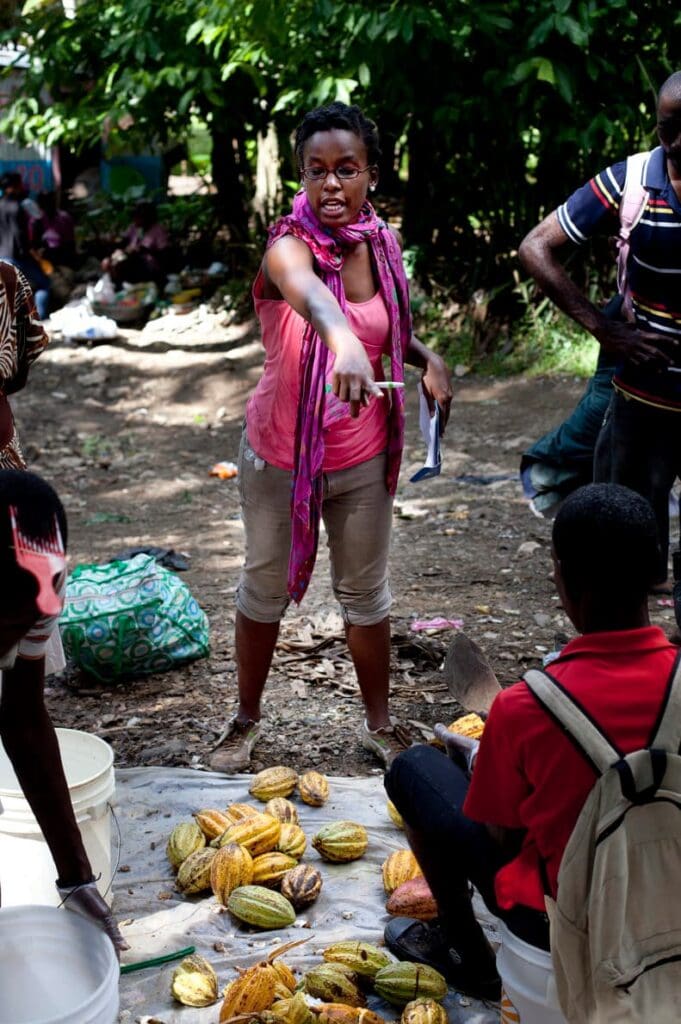
Inside sits the payoff: a lemon-shaped mass of cacao beans surrounded by glistening white pulp, which gives off a tart, earthy smell. A worker scoops the beans into a white plastic bucket and tosses the husk into a pile. When they’re full, the buckets are sealed and loaded into a pickup for the journey to Askanya’s fermenting and drying facility.
Sanon buys half her cacao this way; in the future, she plans to expand these direct buys to as many as 3,000 farmers. She also buys pre-processed beans from a federation of Haitian farmer cooperatives. Soon, she plans to further diversify her supply by starting a 15-hectare farm on land the company already owns.
“In Haiti, having a plan B isn’t enough,” Sanon said. “You have to have backup plans all the way through to Z. A diverse cacao supply will give us that, helping us grow our capacity and continue to help farmers.”
Sanon says demand for cacao is growing, from 4,000 tons per year when Askanya started to around 6,000 tons today. That means higher prices for farmers and more cacao trees in the ground, helping to stabilize Haiti’s badly deforested hillsides.
U-M assistant professor Amy Cohn teaches the methods class that Sanon credits with helping her start Askanya. Cohn says this combination of engineering theory and on-the-ground know-how is what sets industrial and operations engineers apart.
“Engineers like Corinne have to understand this whole world outside the core equations. And there’s something exciting about that,” said Cohn, an Arthur F. Thurnau Associate Professor of Industrial & Operations Engineering. “Whatever you care about, you can take this set of industrial operations engineering tools and use it to make a difference. So it’s not surprising to me that this is something that an industrial engineer would choose to do. Plus, there’s chocolate.”
Back at the gas station, the crew has decided to push through the flood to reach Cap Haitien. Slogging through knee-deep floodwaters and a crush of stranded vehicles, it takes them nearly two hours to travel two miles to the hotel Sanon has secured. They arrive at 2 a.m. and are back on the road by 6 to get their cacao to the fermentation and drying center in time.
Built from scratch by Sanon and her team, the center sits at the end of a narrow dirt path that winds across fields and farmland. Lugging a bucket in each hand, the crew carries the cacao over a muddy creek past cows, chickens and pigs toward the plastic-covered drying tunnels ahead. As they approach, the smell of fermenting cacao gets stronger: a decidedly un-chocolatey odor somewhere between spoiled fruit and vinegar. At long last, they dump the cacao into a coffin-sized wooden box.
Careful fermenting and drying bring out the cacao’s distinctive fruit and floral notes, helping Askanya claim top dollar for their finished chocolate bars. That’s important because Sanon needs to squeeze maximum value from every bean to fund the labor-intensive harvesting and transportation process and pay the farmers a good price. So, working with a chocolate consultant from Seattle, she designed a system of self-contained fermenting and drying modules.
First the cacao ferments, sandwiched between layers of burlap and banana leaves, for a week. The beans are then transferred to wooden drying racks where they dry for two to three weeks, taking on a brown color that begins to look like chocolate. Drying is an unpredictable process that varies with the weather, so Sanon has incorporated six drying tables for each of the 10 fermentation boxes. The boxes must be filled at least 90 percent full to ferment properly, so they need to be carefully sized to hold one day’s cacao harvest. Ultimately, the center will grow to 80 tons of capacity, enough to accommodate larger buys from small farmers and process the cacao from the planned on-site farm.
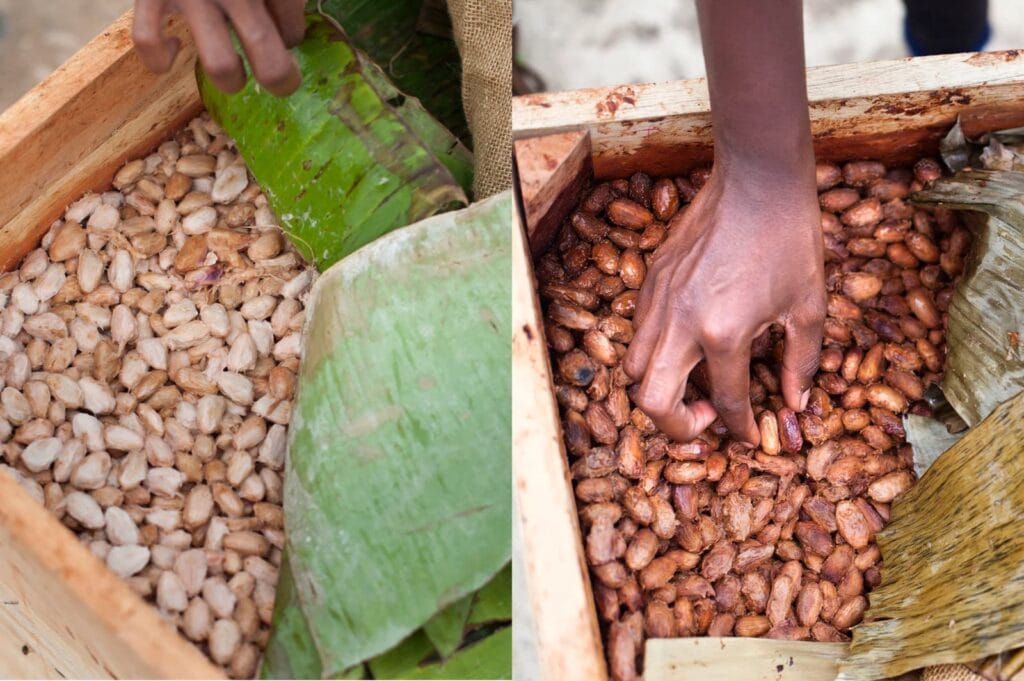
For the harvesting crew, this trip has been even more grueling than most. But James Dobson Bélizaire, Askanya’s head of production, takes it in stride. Like the beans themselves, he has travelled a long and difficult road to get here.
Bélizaire grew up in Cité Soleil, one of the most dangerous and destitute slums in Port-au-Prince. His family was poor – some nights, dinner was a stalk of sugarcane. Only about half of Cité Soleil children attend school. Bélizaire’s parents saw that he was bright and made sure he was one of them.
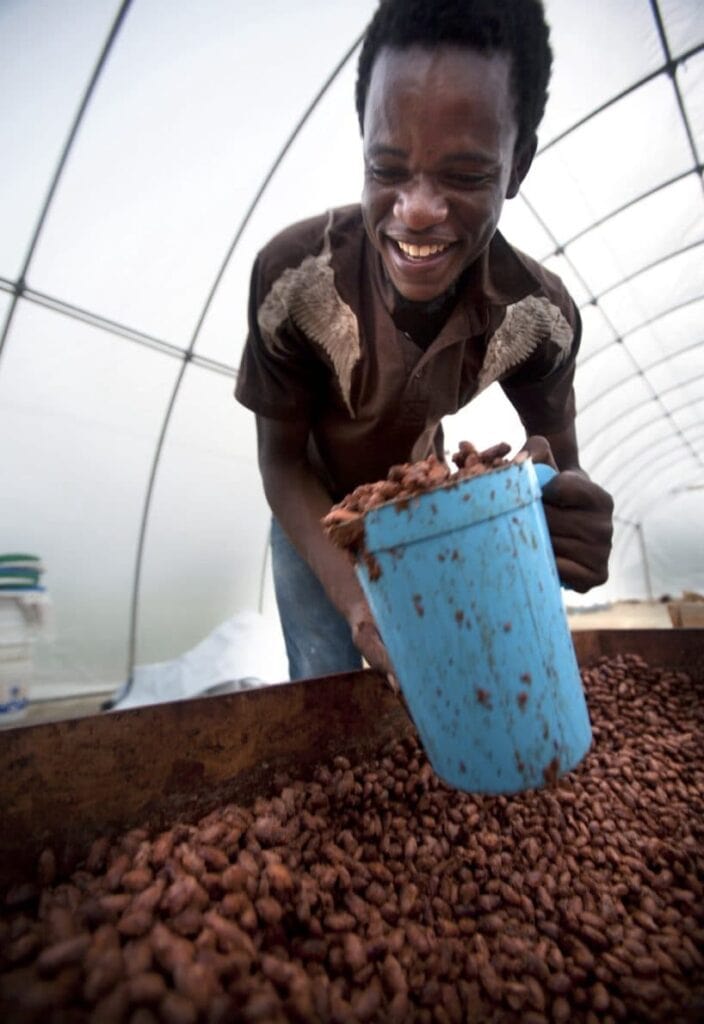
In the 1990s, things got more difficult: president Jean-Bertrand Aristide began giving guns to Cité Soleil’s street children in an attempt to tighten his grip on power. The family had to flee to northern Haiti to escape the violence.
“I was lucky,” he explains. “I had a good family and they made sure I stayed away from the guns. But the other kids all had them, and it was too dangerous to stay.”
Still, he continued his education. In 2007, he was one of 4,900 students who applied for admission to Université d’Etat d’Haiti’s business school. Of those, 300 passed the exam. Bélizaire was among them.
Now 28, he makes about $450 per month, an impressive salary in a country where per-capita GDP is $863. Bélizaire sees the job as a way to help Haiti reclaim its agricultural heritage and make a product that shows people – inside Haiti and elsewhere – what Haitians are capable of.
“Before Askanya, all our chocolate came from the USA. Now that has changed. I’m helping the people who plant cacao get more money, I’m helping the other workers get money and I’m promoting Haiti. We can transform Haiti by growing and processing more food here, and I plan to be a part of it.
Askanya’s factory is easy to spot, a bright pop of yellow and turquoise that stands out among the battered buildings on Ouanaminthe’s noisy main street. This is the final destination for the cacao beans, where they’re roasted, ground and turned into one of three different flavors of high-end chocolate bars.
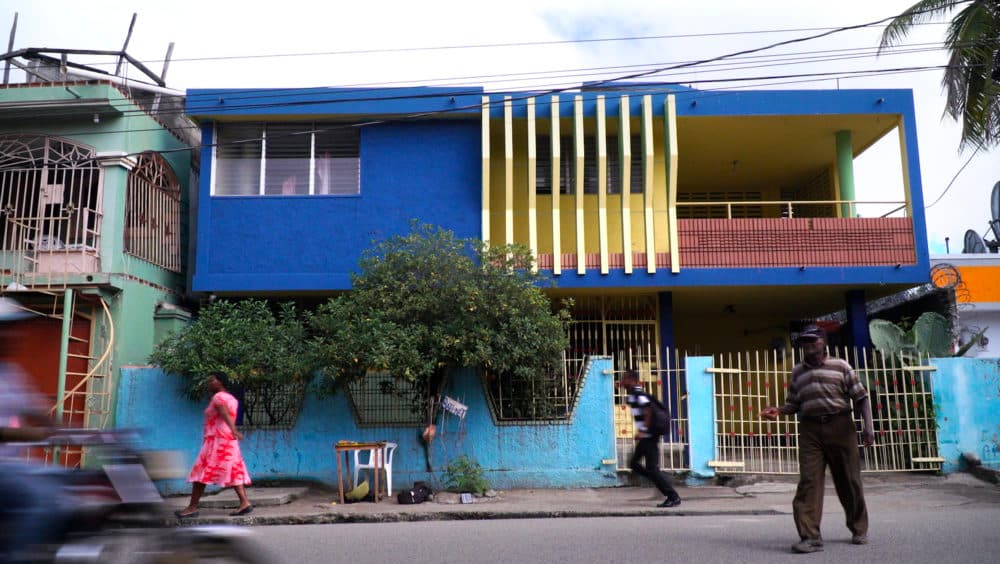
What stands out most about the factory is its small size. It occupies the first floor of a modest two-story house with bright yellow concrete walls and well-worn tile floors. There are no assembly lines, no conveyors, no gleaming stainless steel tanks.
Instead, 32 year-old Jocelyne Diometre sits in the front room surrounded by 80-pound sacks of cacao beans. She’s sorting them by size, an essential step because small beans roast faster than large ones. One bean at a time plinks into the steel bowls in front of her. Once a bowl is full, she pours it onto a metal baking sheet and slides it into an electric oven about the size of a countertop microwave. 30 minutes later, she takes it out and dumps the beans on a metal screen to cool.
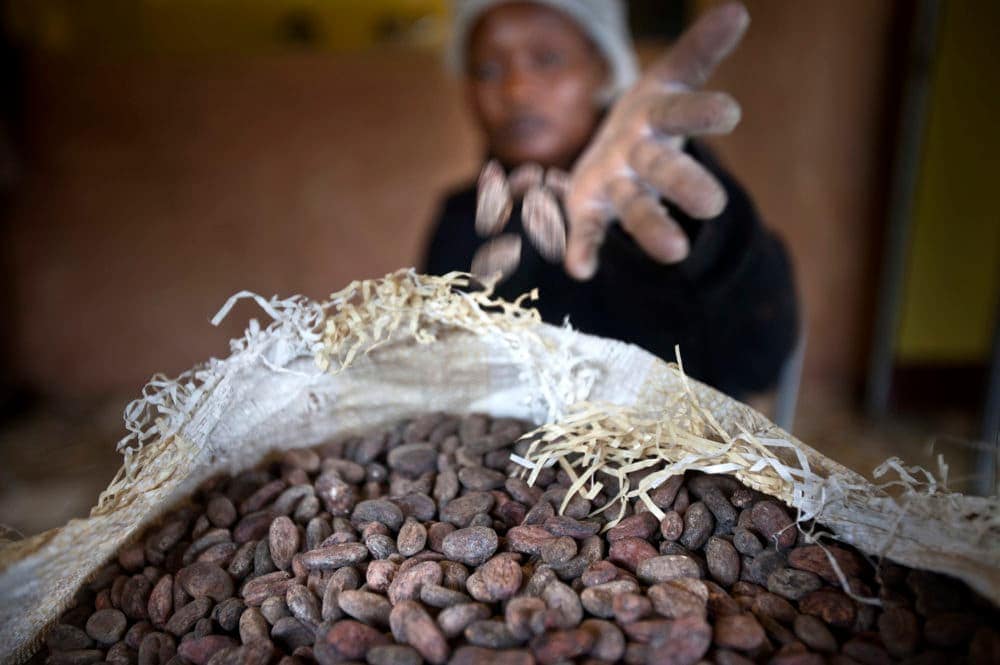
Diometre has worked in Askanya’s factory for about a year – some days she sorts beans, other days she handles the pouring or the wrapping of the bars. She makes about $100 per month, enough to send her three children to a Catholic school, one of the best in Ouanaminthe. Like Askanya’s other employees, the company pays the taxes on her earnings and also provides meals, English lessons, disability insurance, paid holidays and a year-end bonus.
Before starting on at Askanya, Diometre was a live-in housekeeper in the Dominican Republic. She was away from home six days a week, with risky trips back and forth across the border to work. Once, she was accused of stealing and had to stay in jail until it was discovered that her employer’s relative was the real culprit. Here, she’s learning about the chocolate business, and she has begun thinking about what her children, ages 10, 9 and 5, might do with the education they’re getting.
“I’d like my two boys to be agronomists,” she says, “And my daughter?
A doctor.”
Askanya employs five other factory operators, all women. Sanon
works to create a culture at Askanya that’s much different than most Haitian employers.
“Haiti is a very patriarchal society,” Sanon explains. “I want people to see that women can be great employees and leaders. I try to make sure that everyone is treated equally, whether you’re a girl or a boy, Catholic or Protestant or Vodouisant.”
After roasting, the cacao goes through a process called cracking, separating the outer shell from the meat inside, called the nib. First, a worker cracks the beans open with an old peanut butter grinder. Next, the ground beans are spread onto a flat, shallow Haitian basket called a laye.
Sitting in front of a fan, a worker scoops beans out of the laye and holds the scoop high, slowly shaking the beans out. The fan blows the lighter shells away while the heavier nibs fall into the laye.
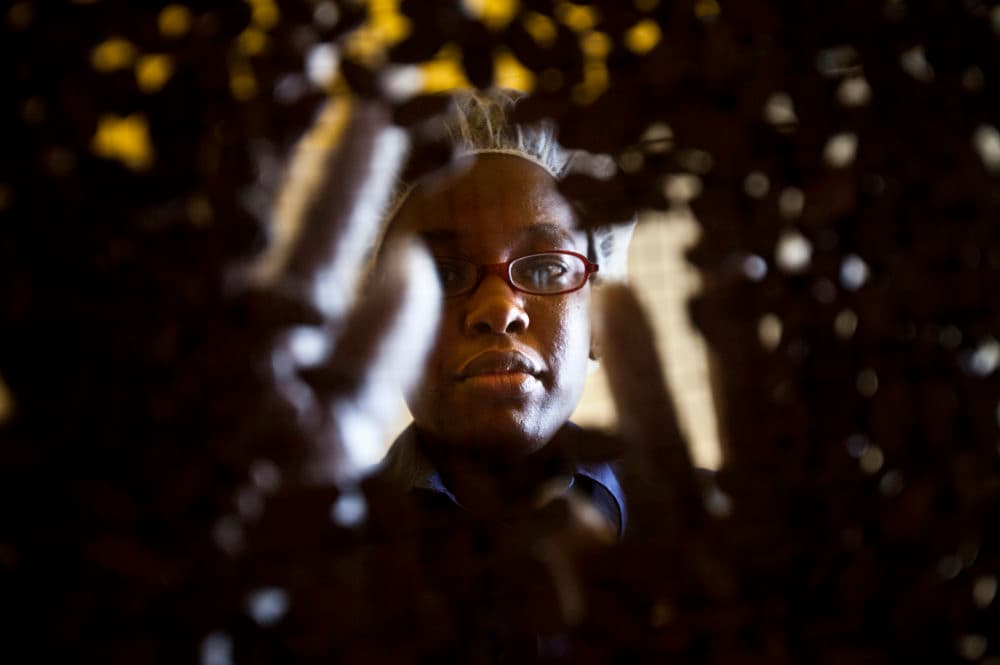
The nibs are then pulverized in a process called conching. This requires the factory’s most specialized equipment – three squat, knee-high machines. Their steel urns turn slowly as heavy granite wheels inside crush the nibs into silky brown liquid chocolate. It’s at this stage that other ingredients – milk, cacao butter or other flavorings, depending on the recipe – are added. Conching takes 72 hours and sometimes has to be stopped and restarted as the electricity comes and goes.
And electricity does come and go. Ouanaminthe’s electrical grid, when it’s working, provides power from about 6 p.m. until midnight. The rest of the time, the only electricity comes from the diesel generator that drones out back. Fuel is a big expense, as is bringing in maintenance technicians from the larger city of Cap Haitien. But it’s the only way.
From here, the liquid chocolate goes into a sealed cold room – the only room at Askanya with air conditioning. It’s poured into a small tabletop machine for tempering, a series of precise heating and cooling cycles that nudge the cacao molecules toward a particular crystal structure. This produces the glossy sheen that chocolate buyers expect. It’s then ladled by hand into molds and cooled for about 30 minutes in a refrigerator. Finally, the cooled bars are trimmed by hand and wrapped by two workers, who carefully crease two layers of wrapping over each and every finished bar.
Askanya’s labor-intensive operation is a matter of necessity in Haiti. Economies of scale don’t work and neither does just-in-time delivery. There isn’t enough electricity to run big machines, and if they break, there are no parts to fix them. But for Sanon, engineering isn’t about machines or technology. It’s about designing the best system and making it work, day in and day out.
“I’m a U-M IOE engineer – that’s how we are, right?” she explains. “We’re tough, we try hard. We try different ways until it works.”
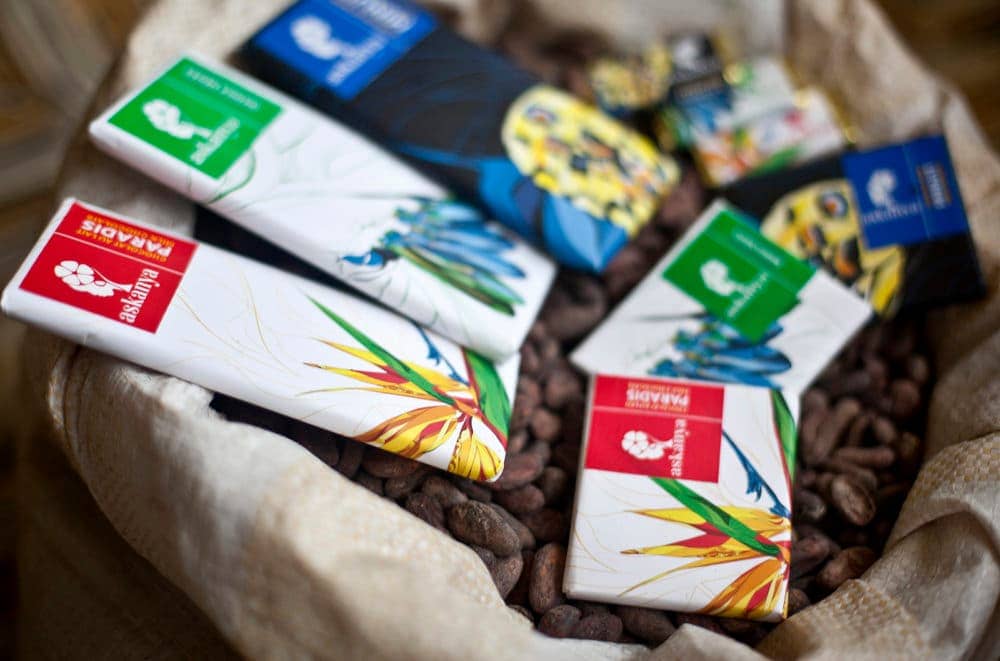
The approach has enabled Askanya to succeed where few others have. The factory may be small, but its added value funds the entire Askanya supply chain. Vansteenkiste, who has started several Haitian ventures herself, says it’s a game changer.
“Value-added processing is where money can be made. Haiti does very little of it because processed imports are cheap to buy and too competitive, but community based organizations do design niche projects,” Vansteenkiste explains. “The beauty is that they invest back into the people; they don’t take the money and put it in a shareholder’s pocket.”
To Sanon, Askanya is also an example that shows would-be Haitian entrepreneurs, the government and others what small business can do. As more cacao becomes available and Askanya’s farm comes online, she hopes to quadruple capacity, expanding to 10 to 12 flavors over the next five years. Ultimately, she believes this could go far beyond chocolate.
“I think the future of Haiti is going to be a mix of agricultural and light manufacturing,” she says. “What we’re doing with chocolate could be done with water bottling, trash removal, juice making. It’s not rocket science. It’s all possible. And it could change a lot of lives.”